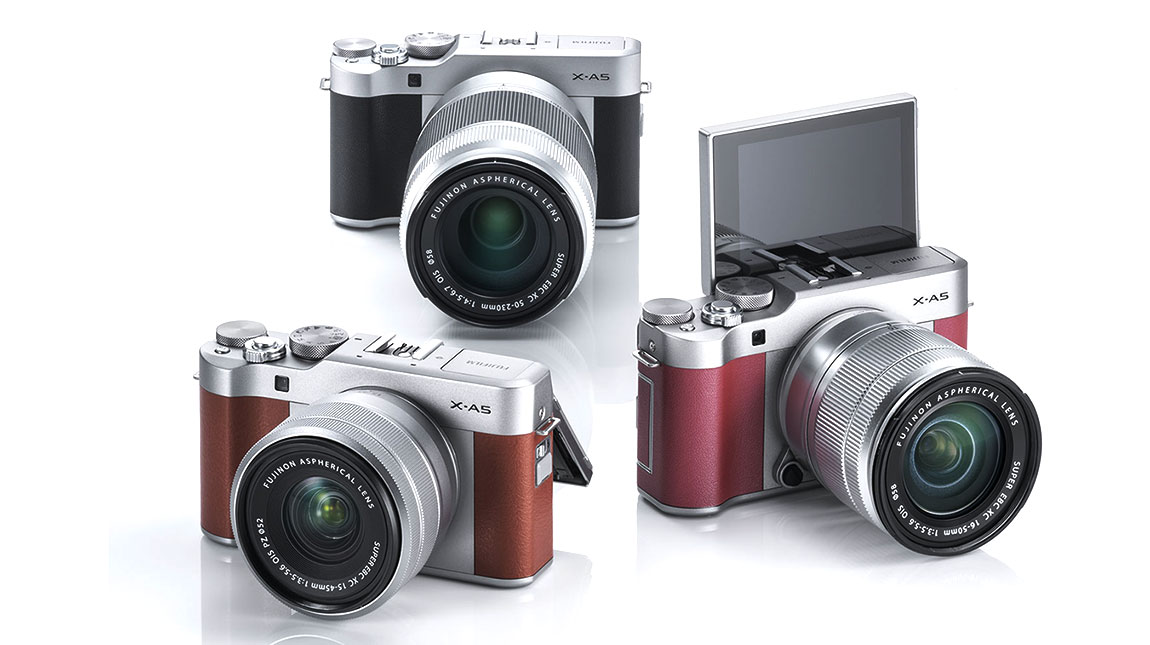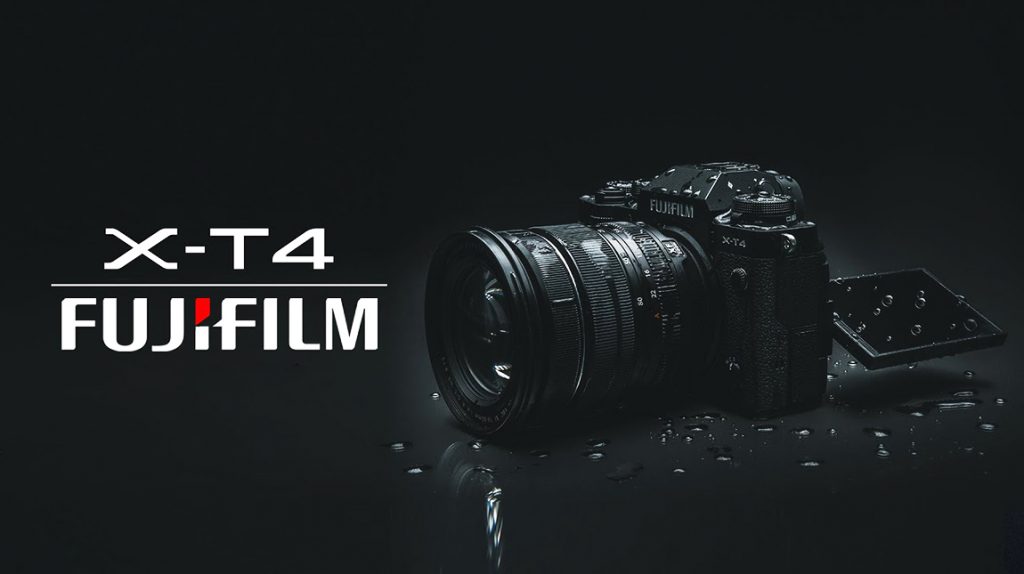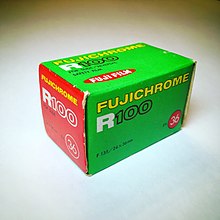






فوجي فيلم
富士フイルム株式会社
| التأسيس |
20 يناير 1934
|
|---|---|
| النوع | |
| الشكل القانوني | |
| المقر الرئيسي | |
| موقع الويب |
| الشركة الأم |
Fujifilm Holdings
|
|---|
|
|
|
| الشركات التابعة |
|
|---|
Fujifilm (Netherlands) Fujifilm (United Kingdom)
|
|
|
| الصناعة | |
|---|---|
| المنتجات |
العديد من المنتجات المتعلقة بالتصوير
|
| الموظفون |
76,358 (2008)
|
|---|
| العائدات |
▲¥2.846 ترليون (2008)
|
|---|
| الربح الصافي |
▲¥104.431 مليار (2008)
|
|---|
| البورصة |
بورصة طوكيو (4901)
|
|---|
شركة فوجي فيلم القابضة (باليابانية: 富士フイルム株式会社 فوجي فيلم كابوشكي كايشا) والتي تعرف بشكل شائع باسم فوجي فيلم هي شركة يابانية تعرف بصناعة أدوات التصوير والكاميرات والتي يوجد مقرها في طوكيو ميدتاون في أكاساكا، ميناتو، طوكيو. يتبع لشركة فوجي فيلم 223 شركة فرعية لبحوث وتصنيع وتوزيع المنتجات، مع وجود معامل لها في آسيا وأوروبا والولايات المتحدة الأمريكية. كما أنها تنتج وسائط تخزين الكمبيوتر الاستهلاكية، مثل الأقراص المضغوطة وأقراص دي في دي والأقراص المرنة. ما يميز شركة فوجي فيلم هو اللون الأخضر الذي يطغى على صناديق منتاجتها وملابس موظفيها.
ـــــــــــــــــــــــــــــــــــــــــــــ
فوجي للصناعات الثقيلة
فوجي للصناعات الثقيلة المحدودة (باليابانية: 富士重工業株式会社, Fuji Jūkōgyō Kabushiki-gaisha) هي شركة يابانية تعود أصولها لشركة ناكاجيما للطيران (أُسست عام 1917م) التي كانت رائدة صناعة الطائرات للجيش الياباني خلال الحرب العالمية الثانية.
وبعد الحرب تم إحلال الشركة من قِبل الحكومة عام 1950م.
تم إنشاء الشركة عام 1953م باتحاد خمس شركات يابانية ليكوّنوا واحدة من أكبر شركات صناعة المواصلات باليابان. لديها الآن أكثر من 15000 عامل وتُدير 9 مصانع وتبيع في أكثر من 100 دولة حول العالم. تُصنع حالياً علامة السيارات سوبارو، ويصنع قسم الطيران بها قطع لشركة بوينغ وأيضاً مروحيات وطائرات نفاثة.
ــــــــــــــــــــــــــــــــــــــــــــــــــــــــــــــــــــــــــــــــــــــ
Fujifilm
Jump to navigation Jump to search

Midtown West, the current global headquarters of Fujifilm in Tokyo.
|
|
|
Native name
|
富士フイルムホールディングス株式会社 |
|---|---|
|
Romanized name
|
Fujifirumu Hōrudingusu kabushiki gaisha |
| Public KK | |
| Traded as |
|
| ISIN | JP3814000000 |
| Industry | |
| Founded | January 20, 1934 |
| Founder | Daicel Corporation |
| Headquarters | Midtown West, Tokyo Midtown Akasaka, Minato, Tokyo, Japan |
|
Area served
|
Worldwide |
|
Key people
|
|
| Products |
|
| Revenue | |
| Total assets | |
|
Number of employees
|
79,000 (2017)[1] |
| Parent | Fujifilm Holdings |
| Website | fujifilm |
Fujifilm Holdings Corporation (富士フイルム株式会社, Fujifuirumu Kabushiki-kaisha), trading as Fujifilm (stylized as FUJiFILM), or simply Fuji, is a Japanese multinational photography and imaging company headquartered in Tokyo.
Fujifilm’s principal activities are the development, production, sale and servicing of business document solutions, medical imaging and diagnostics equipment, cosmetics, regenerative medicine, stem cells, biologics manufacturing, optical films for flat panel displays, optical devices, photocopiers and printers, digital cameras, color film, color paper, photofinishing equipment, photofinishing chemicals, graphic arts equipment and materials.
History
20th century
Fuji Photo Film Co., Ltd. was established in 1934 with the aim of producing photographic films. Over the following 10 years, the company produced photographic films, motion-picture films and X-ray films. In the 1940s, Fuji Photo entered the optical glasses, lenses and equipment markets. After the Second World War, Fuji Photo diversified, penetrating the medical (X-ray diagnosis), printing, electronic imaging and magnetic materials fields. In 1962, Fuji Photo and U.K.-based Rank Xerox Limited (now Xerox Limited) launched Fuji Xerox Co., Ltd. through a joint venture.
From the mid-1950s, Fuji Photo accelerated the establishment of overseas sales bases. In the 1980s, Fuji Photo expanded its production and other bases overseas, stepping up the pace of its business globalization. Meanwhile, Fuji Photo developed digital technologies for its photo-related, medical and printing businesses.
Like its rival Eastman Kodak which dominated in the US, Fuji Photo enjoyed a longtime near-monopoly on camera film in Japan. By becoming one of the title sponsors of the 1984 Los Angeles Olympics (an opportunity that Kodak passed on), offering cheaper camera film, and establishing a film factory in the US, Fuji gained considerable market share there, while Kodak had little success in penetrating Japan. In May 1995, Kodak filed a petition with the US Commerce Department under section 301 of the Commerce Act arguing that its poor performance in the Japanese market was a direct result of unfair practices adopted by Fuji. The complaint was lodged by the US with the World Trade Organization. On January 30, 1998, the WTO announced a “sweeping rejection of Kodak’s complaints” about the film market in Japan.[2][3]
21st century
The new millennium witnessed the rapid spread of digital technology, and demand for photographic films plunged in line with the growing popularity of digital cameras. In response, Fuji Photo implemented management reforms aimed at drastic transformation of its business structures. Even as early as the 1980s, the company had foreseen the switch from film to digital, so “it developed a three-pronged strategy: to squeeze as much money out of the film business as possible, to prepare for the switch to digital and to develop new business lines.” While both film manufacturers recognized this fundamental change, Fuji Photo adapted to this shift much more successfully[2] than Eastman Kodak (which filed for bankruptcy in January 2012). Fuji Photo’s diversification efforts also succeeded while Kodak’s had failed; furthermore Kodak built up a large but barely profitable digital camera business that was undone quickly by smartphone cameras.[2]
In September 19, 2006, Fujifilm announced plans to establish a holding company, Fujifilm Holdings Corp. Fujifilm and Fuji Xerox would become subsidiaries of the holding company. A representative of the company reconfirmed its commitment to film, which accounts for 3% of sales.[4]
On January 31, 2018, Fujifilm announced that it would acquire a 50.1% controlling stake in Xerox for US$6.1 billion, which will be amalgamated into its existing Fuji Xerox business.[5][6][7] The deal was subsequently dropped after intervention by activist investors Carl Icahn and Darwin Deason.[8]
Subsidiaries
Fuji Xerox is a joint venture between Fujifilm and Xerox Corporation of North America. Fujifilm bought Sericol Ltd., a UK-based printing ink company specializing in screen, narrow web, and digital print technologies in March 2005.[9]
Fujifilm de México is a Fujifilm subsidiary in Mexico that sells Fujifilm products since 1934 and has been recognized as one of The Best Mexican Companies (Las Mejores Empresas Mexicanas) from 2012 to 2015, a recognition promoted by Banamex, Deloitte México and Tecnológico de Monterrey.[10]
Company interrelation
- Fujifilm Holdings
- Fujifilm
- Fujifilm Imaging Systems
- Fujifilm Medical
- Fujifilm Pharma
- Fujifilm RI Pharma
- Fujifilm Photo Manufacturing
- Fujifilm Fine Chemicals
- Fujifilm Electronics Materials
- Fujifilm Engineering
- Fujifilm Optics
- Fujifilm Opto Materials
- Fujifilm Global Graphic Systems
- Fujifilm Computer Systems
- Fujifilm Software
- Fujifilm Techno Services
- Fujifilm Techno Products
- Fujifilm Business Supply
- Fujifilm Digital Press
- Fujifilm Media Crest
- Fujifilm Sonosite, Inc.
- Fujifilm Shizuoka
- Fujifilm Kyushu
- Fujifilm Logistics
- Fujifilm VisualSonics
- Fuji Xerox
- Fuji Xerox Printing Systems Sales
- Fuji Xerox Information Systems
- Fuji Xerox System Service
- Fuji Xerox Interfield
- Fuji Xerox Advanced Technologies
- Fuji Xerox Manufacturing
- Fuji Xerox Service Creative
- Fuji Xerox Service Link
- Fuji Xerox Learning Institute
- Toyama Chemical
- Taisho Toyama Pharmaceutical
- Fujifilm Business Expert
- Fuji Color Photo Center [11]
- Fujifilm
Products
Photographic film
- Fujifilm photographic films
- Motion picture film stock.
- Fujichrome color reversal (slide) films.
- Velvia: one of the most saturated and fine-grained slide films, valued by nature and landscape photographers.
- Provia: a slide film giving more natural colors than Velvia
- Astia: a fined grained, low contrast slide film often used for studio or portrait applications
- Sensia: a low-contrast consumer slide film; the current emulsion is considered to be identical or near-identical to Astia in the professional line.[12][13]
- Fortia: slide film, featuring extremely vivid color rendering suitable for flower photography and other high-saturation applications (for Japanese market).
- Fujicolor color negative (print) films
- Fujicolor Pro 160S, 160C, 400H, and 800Z (formerly NPS, NPC, NPH, and NPZ): professional films with different levels of contrast
- Reala: the first film to use the fourth cyan-sensitive layer, currently sold under Superia Reala name
- Superia: intended for snapshots
- Press: Cut from the same emulsion stock as Superia, but cold stored and sold as a professional film.
- Fuji Neopan Professional black & white negative film. As a side note, Neopan 400 and 1600 were designed to use the same developing times, and can be developed in the same tank/machine and developer combination simultaneously. ACROS and SS do not share this feature.
- Neopan SS: ISO 100 film, most common and least expensive Neopan film
- Neopan ACROS: ISO 100 film, finer grain than SS but usually more expensive
- Neopan Presto: ISO 400 speed film
- Neopan Super Presto: ISO 1600 for low-light shooting or fast action
Cameras and lenses
- Fujifilm X-series cameras
- The Fujifilm FinePix series of digital cameras including:
- Fujifilm X-mount compatible Mirrorless interchangeable-lens cameras like the X-Pro1, X-A1 etc.
- Nikon F-mount compatible digital SLRs like the FinePix S5 Pro
- Compact cameras like the FinePix F-series and FinePix Z-Series, Fujifilm X100 and X100S
- Waterproof and shockproof FinePix XP-Series digital cameras
- The Fujifilm GFX 50S, medium format digital, announced in 2016. This uses the Fuji G-mount lenses, released in 2017
- The Clear Shot series of 35mm compact cameras
- Instax series of instant camera
- Fotorama series of instant camera
- Various rangefinder cameras, and older Fujica film cameras
- Professional film cameras such as the GA645,[14] GW670, GW690, GF670, GF670W and Fuji GX680 6x8cm medium format cameras
- Fujinon camera lenses and binoculars: including the most widely used television lenses in the world
Other
- Photographic paper
- Inkjet printer paper
- Magnetic media, including audiotape (also includes the Axia brand) until 2009, videotape, Magnetic tape data storage and floppy disks
- Optical media, such as DVDs and CDs, mostly produced by Ritek and Taiyo Yuden; some by Philips
- Flash memory
- Photostimulable Phosphor Plate – X-ray film.
- Base material for LCD displays
- instax: Fuji instant film packs and backs for sheet film cameras
- Recording Media
- Microfilm
- Minilab equipments, announced in 2006 a global alliance with Noritsu Koki, together holding a market share of more than 80% of the global market
- Digital X-Ray, digital mammography and computed radiography devices
- Synapse Radiology PACS
- Synapse Cardiovascular PACS
- Synapse RIS
- Ultrasound systems
- Endoscopy
- Specialty Chemicals
- Biologics contract manufacturing and development
- Biomaterials
- Regenerative medicine
- Cosmetics (ASTALIFT series, Nanolift series)



























